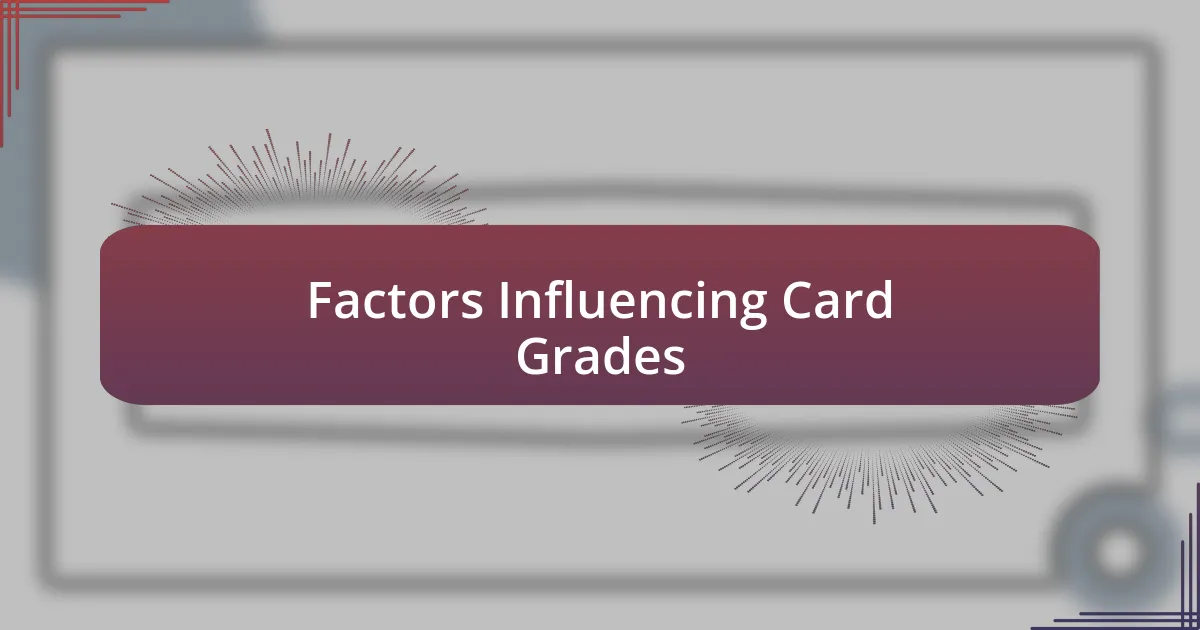Key takeaways:
- Card grading is essential for assessing the physical condition and market value of collectible cards, impacting buying, selling, and overall investment decisions.
- Common grading systems like PSA, BGS, and CGC have unique methodologies, influencing how collectors evaluate their cards.
- Factors such as surface quality, centering, and corner condition significantly affect grading outcomes, highlighting the importance of attention to detail in card collecting.
- Choosing the right grading service involves considering reputation, turnaround times, and alignment with personal collecting goals.

Understanding Grading Collectible Cards
When I first dipped my toes into the world of collectible card grading, I was both excited and overwhelmed. It felt like stepping into a secret club with its own language and rules. Understanding how cards are graded involves recognizing the nuances of condition, rarity, and the overall market influence. Have you ever held a card that felt pristine only to be told it’s not a “Gem Mint”? That initial shock is common, but it taught me the importance of becoming well-versed in grading standards established by organizations like PSA and BGS.
Grading is fundamentally about assessing a card’s physical condition, which includes everything from centering to corners, surface, and edges. For instance, when I submitted my first batch of Pokémon cards, I was nervous but hopeful. The grades assigned to cards can dramatically affect their value, so understanding how these grades are determined was crucial for me. The first time one of my cards came back as a high grade, the thrill was indescribable; it was as if I had unearthed a hidden treasure.
Moreover, the emotional aspect of grading can’t be ignored. Cards often carry sentimental value that grading companies may overlook. I remember how my childhood baseball card, a little worn but brimming with memories, was graded lower than I anticipated. It made me wonder—how do we balance emotional attachment with market perception? This question is at the heart of collecting, pushing us to constantly evaluate what these items truly mean to us beyond mere numbers and grades.

Importance of Card Grading
The significance of card grading cannot be overstated, as it serves as a standardized measure of a card’s condition and value. When I got my first graded card back, I remember the rush of excitement—it felt like my investment was validated. This objective assessment can help collectors and investors navigate the market with confidence, reducing the chances of overpaying for a card that may not be in the expected condition.
Here are key importance points of card grading:
- Market Value: A higher grade typically translates to increased value, impacting buying and selling decisions.
- Trust and Transparency: Grading provides a uniform standard that fosters trust among buyers and sellers.
- Protection: Graded cards are often encapsulated, protecting them from damage and wear over time.
- Liquidity: Graded cards are generally easier to sell, as potential buyers feel reassured by the official assessment.
- Data-Driven Decisions: Grading gives collectors data they can use to strategize their purchasing or selling timelines.
I distinctly remember the first time I faced a situation where a seemingly perfect card came back with a lower grade than I hoped for. At first, I felt disappointed, but reflecting on that experience allowed me to appreciate the importance of expertise in assessments. It was an eye-opener, reminding me that knowledge is power in the collectible card community.

Common Grading Systems Explained
There are a few grading systems commonly used for collectible cards, each with its unique scale and methodology. The most recognized ones are PSA (Professional Sports Authenticator), BGS (Beckett Grading Services), and CGC (Certified Guaranty Company). I remember receiving my first PSA-graded card; the pristine 10 grade felt like a badge of honor, showcasing a perfect condition. It’s fascinating how a number can evoke such pride and possess significant value.
When I first encountered BGS, I noticed their sub-grading system, which evaluates centering, edges, corners, and surface quality individually. This thorough assessment allowed me to appreciate the nuances of my cards more deeply. Sometimes, I’d find myself caught up in the details, spending hours analyzing my collection based on these grading criteria. It’s amazing how being aware of these specifics can enhance your collector’s experience.
CGC has made its mark primarily in comic book grading but is increasingly recognized in the sports card realm. Their approach emphasizes preservation, and seeing my cards secured within their slabs gave me peace of mind. Each grading company has its merits, and understanding their unique systems can undeniably aid collectors in making informed decisions.
| Grading Company | Grading Scale |
|---|---|
| PSA | 1 to 10 (10 is Gem Mint) |
| BGS | 1 to 10 with Sub-grades (e.g., 10/9.5/9/8.5) |
| CGC | 1 to 10 (10 is Pristine) |

Factors Influencing Card Grades
When I think about card grades, several factors come to mind that can significantly influence the outcome. One of the most crucial elements is the card’s surface. I once had a beautiful vintage card that looked perfect from a distance, but upon close inspection, I noticed tiny scratches that impacted its overall grade. It’s a classic reminder that what we see isn’t always the full picture.
Another significant factor is centering. I remember picking up a rare card that was slightly off-center. While it still held sentimental value, its grade suffered because of that imperfection. Have you ever found a card that you thought would be a gem but then realized it didn’t measure up due to such a small detail? It can be a bit disheartening, but it also teaches us the importance of paying attention to the finer points.
Finally, the condition of the corners is vital when grading. I’ve had cards with sharp corners that instantly boosted their appeal, while others with worn edges sat in my collection feeling a bit neglected. It really emphasizes how much these tiny details can alter a card’s fate in the grading process. Have you felt that mix of excitement and disappointment when you see those corner imperfections on cards you love? It’s all part of the journey of collecting.

Choosing a Grading Service
Choosing the right grading service can feel overwhelming, especially with so many options available. From my experience, it’s essential to research the credibility and reputation of a service. I remember when I first decided to grade some of my cards; I chose a service based solely on their flashy website. Sadly, the grade I received left me questioning their expertise.
Another factor to consider is turnaround times. I’ve had cards graded with one service that took months, while a more reliable option had them back to me in a few weeks. It’s important to weigh how quickly you want your cards returned against the quality of grading and customer service. Ever been in a position where you had to choose between speed and reliability? That decision can shape your collecting experience.
Lastly, don’t underestimate the importance of the grading scale and how it aligns with your collecting goals. I’ve often found that different services offer slightly varying scales, which can influence how I value a card. Finding a grading service that fits your personal standards can ultimately enhance both your collection’s worth and your enjoyment of it. Have you thought about how the right grading service could change your perspective on your collection? It certainly has for me.




